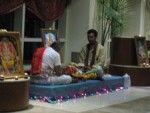This Little Light of Mine

On Saturday, November 3, students, faculty and families alike gathered in the recently completed Robert H.N. Ho Science Center to celebrate Diwali, the Hindu Festival of Lights and Indian New Year. According to representatives from the Hindu Student Association (HSA), approximately 215 people attended the festival despite the cold weather.
The HSA carefully planned the event and made the appropriate preparations in conjunction with the Center for Leadership & Student Involvement (CLSI). The opening of the Ho Center provided the HSA with the ideal place to hold the festival, and the amount of space in the lobby allowed for the attendance of such a large crowd.
Member of the HSA senior Swetha Peteru was pleased with the event’s popularity and success.
“Our goal in any of our events is to further our mission, which is to educate ourselves and the Colgate community about Hinduism and its practices,” said Peteru.
Sponsored by the HSA, the festival included a brief introduction of Diwali by Visiting Assistant Professor in Environmental Studies Nayna Jhaveri and a prayer service given by a priest from Syracuse, followed by an authentic Indian meal after the ceremony. Attendees seated themselves on mats laid out on the floor and enjoyed the bright string lights, candles and tapestries strung throughout the Ho Center second floor lobby.
After wishing everyone present a “Happy Diwali,” Jhaveri explained in her introduction that the underlying goal of Diwali was “to dispel darkness or ignorance.” According to Jhaveri, Diwali, also known as Deepawali, is prominent in India, Nepal, Guyana, Thailand, Trinidad, Siam and Malaysia. She said that the festival commemorates, amongst other things, Lord Ram’s return home after defeating the evil king Ravan. Rows of lamps are placed outside homes to welcome Lord Ram back from the forest during the festival.
Diwali represents the triumph of light, symbolizing knowledge and prosperity, over darkness, which is representative of ignorance and poverty. The celebration focuses on the beliefs that darkness and evil are consistently conquered by light and goodness, and that good actions are justly rewarded. Diwali’s ultimate objective is to remove evil, whether in the form of rage, hate, lethargy or envy, from everyone. The ceremony aims to have its participants discover the good in others.
Following Jhaveri’s explanation of Diwali, the priest began the service with the ceremonious ringing of bells and lighting of a lamp. The three pictures placed at the front of the lobby for worship included lord Ganesh, remover of obstacles, goddess Lakshmi, goddess of wealth, and Saraswati, goddess of education.
Upon the service’s completion, all were invited to line up to waft the steam from the kalash, a brass instrument containing water used in the ceremony, towards them and take a nut or raisin from a tray.
Meanwhile, a line for dinner, ending only at the doors leading into the Ho Center, had already formed, and attendees retrieved their dinner then sat back down on the mats to relax and enjoy the Indian meal and sweet dessert with friends.






